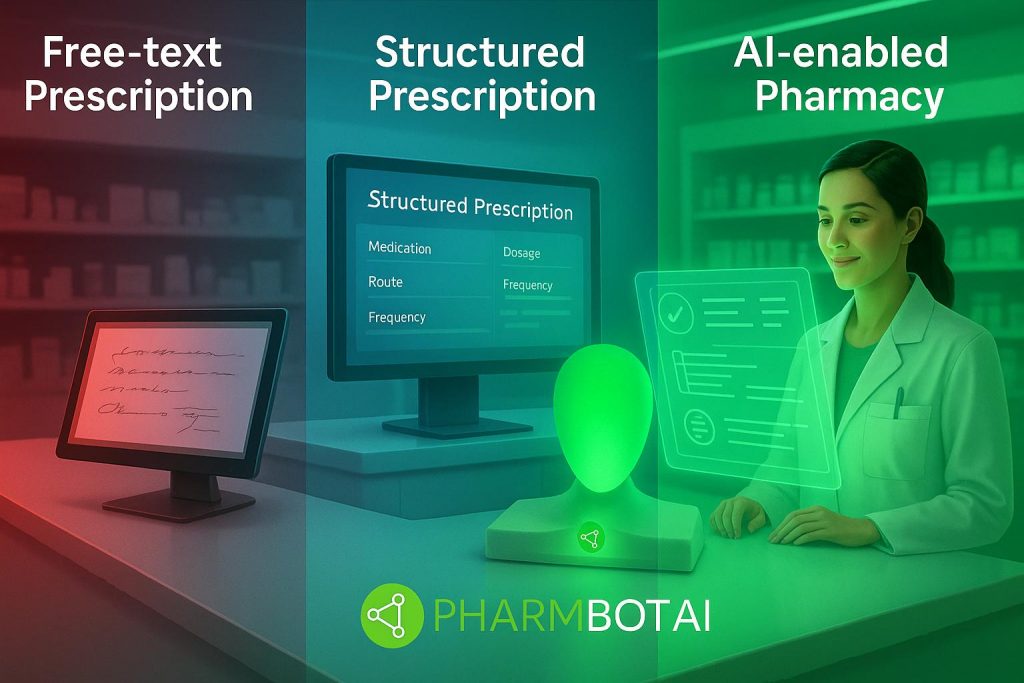A Global Change in Motion
Imagine every prescription arriving in a format that is instantly clear, structured, and safe. No ambiguity. No chasing prescribers for clarification. No unnecessary delays for patients waiting at the counter.
This isn’t a distant dream it’s about to become a reality in the United States.
From 2027 onwards, every U.S. pharmacy will be required to comply with new NCPDP standards, transforming how prescriptions are written and shared. On the surface, it may look like a technical update. In truth, it is a foundation shift.
- Prescriptions will move from free-text notes to structured, machine-readable instructions
- AI will finally have the clean, standardised data it needs to act on
- Providers and pharmacies will be able to communicate without silos
The goal is simple but powerful: clearer prescriptions, fewer errors, faster coordination, and AI-enabled pharmacy at scale.
Why This Matters for Patients and Pharmacists
Every pharmacist knows the frustration of unclear prescriptions. A missing dose instruction, a confusing abbreviation, or handwriting that leaves too much to interpretation these aren’t just inconveniences. They’re patient safety risks.
By standardising prescriptions into structured digital formats, the U.S. is not only embracing efficiency, but also making a profound patient safety intervention. Every avoided error is a patient protected. Every minute saved is time pharmacists can reinvest in care, counselling, and clinical services.
For the workforce, this shift means less firefighting, more care. Instead of chasing prescribers or double-checking ambiguous instructions, pharmacists will be supported by AI-driven systems that flag risks instantly. It’s about reducing the burden, protecting the workforce, and enabling pharmacy to expand its clinical role with confidence.
The UK: Waiting or Leading?
Here in the UK, we don’t yet have the same mandate. Structured prescription standards are not a regulatory requirement, and system interoperability remains a significant challenge.
But that doesn’t mean we should wait until 2027 to see these benefits. In fact, waiting comes with a cost: more errors, more inefficiency, and more pressure on an already stretched workforce.
If the U.S. can set a deadline, what’s stopping the UK from moving faster?
Building the Foundations Now
At PharmBot AI, we’ve been asking this very question. That’s why we’ve started laying the same digital foundations that will soon be mandated in the U.S.
- Prescription Verification Service: Using AI to review prescriptions in real time, flagging potential risks and reducing errors before they reach patients.
- AIVAe Platform: Providing pharmacists with structured, audit-ready support for clinical services and patient engagement.
These tools aren’t just about compliance. They’re about future-proofing pharmacy creating an environment where pharmacists can thrive, patients can feel safer, and the NHS can deliver smarter, more coordinated care.
Collaboration Is Key
Technology alone will not deliver this transformation. It requires collaboration at every level:
- Regulators creating the frameworks for safe and effective AI adoption
- IT system providers enabling true interoperability across the NHS
- Pharmacists co-designing and testing solutions so they reflect real practice
- Innovators bringing forward safe, scalable AI tools with patient benefit at their core
When these groups work together, the impact multiplies. The pharmacy of the future is not built in isolation it is co-created.
A Vision for the Pharmacy of the Future
So, what does this look like in practice?
I see a pharmacy where prescriptions flow seamlessly into structured systems. AI supports pharmacists by automatically checking for interactions, verifying appropriateness, and flagging anomalies in real time. Robotics assist with dispensing. Pharmacists spend their time on what matters most, providing clinical care, supporting long-term condition management, and engaging patients in their own health.
This is not a vision of replacement. It’s a vision of empowerment. Technology takes on the repetitive, error-prone tasks, while pharmacists step fully into their role as accessible, trusted clinical leaders in the community and across the NHS.
The Time to Act
The U.S. has drawn a line in the sand with its 2027 mandate. The UK has an opportunity: either wait for regulation, or act now and lead the way.
Pharmacies that see this as a strategic upgrade, not a compliance exercise, will be the ones ready to thrive in the next era of AI-driven care.
For patients, that means safer, faster, more consistent experiences. For pharmacists, it means more time, more impact, and more professional satisfaction. And for the NHS, it means efficiency, resilience, and a future-proofed workforce.
The digital shift in pharmacy is already underway. The only question left is: will the UK choose to wait, or to lead?
References
- NCPDP (2023). SCRIPT Standard Implementation Recommendations. National Council for Prescription Drug Programs. Available at: https://www.ncpdp.org (Accessed: 18 August 2025).
- NHS England (2021). Digital Technology Assessment Criteria (DTAC). NHS England. Available at: https://www.england.nhs.uk/digitaltechnology/ (Accessed: 18 August 2025).
- World Health Organization (2021). Ethics and Governance of Artificial Intelligence for Health. WHO. Available at: https://www.who.int/publications/i/item/9789240029200 (Accessed: 18 August 2025).

